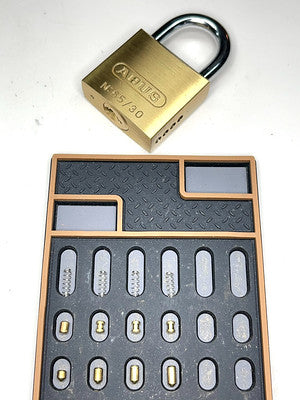How to Pick an ABUS 65 Padlock: Tips and Tricks for Beginners
If you're ready to take your lock picking skills to the next level, the ABUS 65 padlock provides the perfect challenge. Known for its pin-tumbler design and additional security features, this padlock is ideal for those who have mastered basic padlock picking and are looking to improve their technique.
ABUS 65: A Reliable, Low-to-Medium Security Padlock
The ABUS 65 padlock is a pin-tumbler lock designed for low to medium security purposes. Manufactured by ABUS, the ABUS 65 features a solid brass body and a hardened steel shackle, making it highly durable and resistant to wear and tear. It’s one of the most popular locks used in both residential and commercial applications.
Here are the key specifications of the ABUS 65 padlock:
- Lock Type: Pin-tumbler
- Security Rating: Models range from 4 to 6 in ABUS security classification
- Shackle Diameter: From 5mm to 10mm
- Material: Solid brass body with hardened steel shackle and rustproof inner components
- Automatic Locking: Ensures quick and efficient locking
Vulnerabilities of the ABUS 65 Padlock
Despite its robust design, the ABUS 65 is still vulnerable to certain types of lock picking techniques:
- Lockpicking: The traditional method of manipulating the pins inside the lock to unlock it.
- Key bumping: A technique where a key is struck to make the lock open.
- Decoding: A method of determining the correct key cuts without actually using the key.
- Bypass: A technique where the lock is manipulated without directly opening it.
- Impressioning: The technique of creating a key by inserting a blank into the lock.
Tips for Picking the ABUS 65
To successfully pick the ABUS 65 padlock, you'll need to master several lock picking techniques. Follow these steps:
- Ensure you have a quality lock pick set with a variety of tools.
- Begin by applying light tension to the core while inserting your picks into the lock.
- Use a rake tool to move the pins and set them in the correct position.
- Once the pins are set, turn the core using your tension wrench.
- Practice makes perfect—keep refining your technique to improve speed and accuracy.
Picking the ABUS 65 padlock is a great way to improve your skills and prepare for higher-level locks. As you progress, make sure to learn about false gates and other advanced security mechanisms that you may encounter in more complex locks.
Related Articles
Interested in learning more about lock picking? Check out these related articles:






















